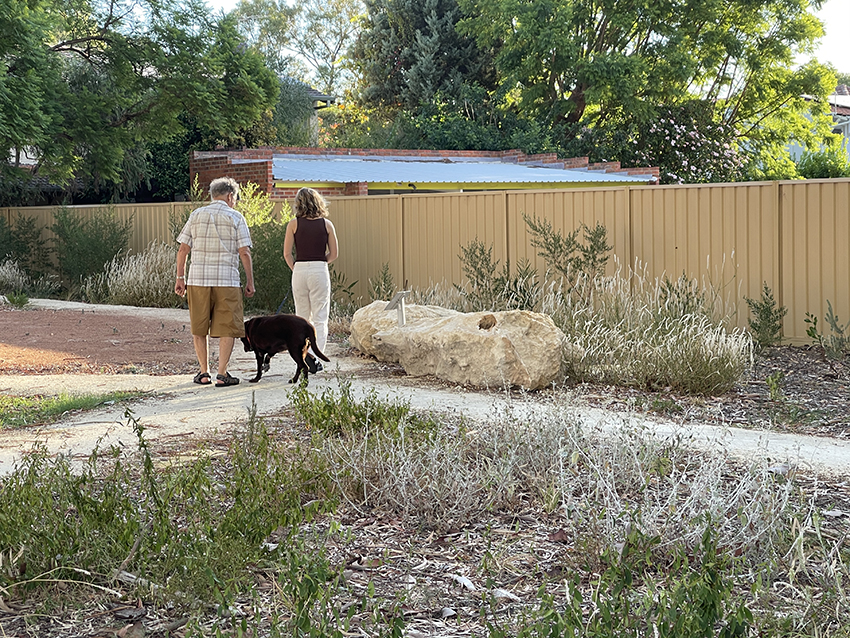This case study relates to Action 32 in the Kep Katitjin – Gabi Kaadadjan Waterwise action plan 3 delivered by the Department of Water and Environmental Regulation and Water Corporation.
An experimental, low maintenance garden that is a hands-on landscape design project is putting research into practice. The main goal of the Living Lab Garden 3 ‘Urban Biodiversity in Design’ is to understand nature and natural processes that occur in an urban environment and to demonstrate how ecological design can strengthen urban biodiversity. The project also recognises that alternative and more sustainable and waterwise solutions may be appropriate ways of maintaining urban green spaces in a drying climate.
Living Lab Garden 3 was established in October 2022 in the Crawley Campus of The University of Western Australia (UWA). It is included in the interdisciplinary research project Lawn as a Social and Cultural Phenomenon in Perth, which was a deliverable for Kep Katitjin – Gabi Kaadadjan Waterwise Perth action plan 2 action 27 Collaborate with universities, local government, industry and the Water Corporation on sustainable design and management solutions for lawns in public green spaces in a changing climate.
One of the project tasks is to test alternative sustainable planting design solutions for urban green spaces (including lawns) in a drying climate. Investigating different mixtures of native grasses and groundcovers to find waterwise and low maintenance solutions for verges, road reserves and other public and private green spaces. This can be important to maintain amenity during extended dry seasons.
The living lab showcases the uniqueness of Western Australian landscapes, demonstrating the waterwise principle of ‘sense of place’ and explores and tests the difficulties in restoring existing urban habitats back to native, diverse and self-sustaining ecosystems. This research can inform how we can design our urban landscapes to be more waterwise and resilient to climate change.
The Living Lab 3 design concept is based on the demonstration of the dynamic character of existing urban landscapes. The low maintenance garden shows the dramatic transformation of Perth’s landscapes from the original native vegetation to a designed colonial garden, an orchard, and a spontaneous weedy space (Garden of the Outcasts). This journey is taken through a series of looped paths that start and finish with the Noongar six seasons – an attempt to return native vegetation and bushland to the urban landscape. Three areas of Living Lab 3 are dedicated to testing native grass species and native groundcovers as new resilient and biodiverse options for covering open spaces.
Living Lab 3 provides a tranquillity space for the local community and allows students, staff and visitors to experience the ongoing research at the UWA School of Design and other UWA Schools. The garden demonstrates new biodiversity potentials for public and private gardens. People are invited to visit Living Lab 3, located at 29 Cook Street, Crawley, Perth.
Living Labs are the joint effort of UWA students and staff with the support of Water Corporation, Department of Water and Environmental Regulation, City of South Perth, City of Rockingham, Turf Growers Association of Western Australia, Murdoch University, Stratagreen, ArborCarbon and Syrinx Environmental.
More information
Urban Biodiversity in Design Living Lab 3
Peer-reviewed articles based on the LAWN project
Ignatieva, M., Hughes, M., Chaudhary, A.K., and Mofrad, F. (2024), The Lawn as a Social and Cultural Phenomenon in Perth, Western Australia. Land 2024, 13, 191, https://doi.org/10.3390/land13020191.
Ignatieva, M., Dushkova, D., Martin, D.J., Mofrad, K., Stewart, K. and Hughes, M. (2023) From One to Many Natures: Integrating Divergent Urban Nature Visions to Support Nature-Based Solutions in Australia and Europe. Sustainability 2023, 15(5), 4640; https://www.mdpi.com/2071-1050/15/5/4640



